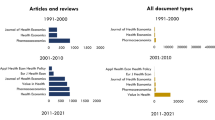Abstract
Introduction
The present study endeavours to provide information on what are the research interests of Brazilian Public Health and how authors can be ranked.
Methods
Post-graduate faculty members ISI data are analysed according to regions. Number of paper and its citations, papers’ type-complexity-cooperation, Bradford’s Law, Shannon’s indexes, time dynamic functions, Lotka’s Law, and ranking functions are examined.
Results
Current production was built up in the last 30 years at a rate of 9.6% articles/year and 12.6% citations/year. 66% of potential authors were present in ISI data records, 64% achieved at least one citation. Research fields do not much depart from the traditional PH purview. More than 66% of authors have just one paper and decrease is steep. Subtle differences call attention to the South region.
Conclusion
Brazilian PH is mainly committed to classical research fields and ranking among authors is narrow.
Similar content being viewed by others
References
Pereira, J. C. R., Escuder, M. M. L., The scenario of Brazilian Health Sciences in the period of 1981 to 1995. Scientometrics, 45(1) (1999) 95–105.
Pereira, J. C. R., Baltar, V. L., Mello, D. L., National Health Innovation System: relations between scientific fields and economic sectors. Rev. Saude Publ., 38(1) (2004) 1–8.
Macías-Chapula, C. A., Hacia un modelo de comunicación en salud pública en América Latina y el Caribe. Rev. Panam. Salud Publica, 18(6) (2005) 427–438.
Barros, A. J. D., Scientific output in the collective health area: journal profile and evaluation by CAPES. Rev. Saude Publ., 40 (N Esp) (2006) 43–49.
Bradford, S. C., Sources of information on specific subjects. Engineering, 137 (1934) 85–86.
Shannon, C. E., A mathematical theory of communication, Bell System Technical Journal, 27 (1948) 379–423 & 623–656.
Lotka, A. J., The frequency distribution of scientific productivity. Journal of the Washington Academy of Sciences, 16(12) (1926) 317–323.
Glänzel, W., Leta, J., Thijs, B., Science in Brazil. Part 1: A macro-level comparative study. Scientometrics, 67(1) (2006) 67–86.
Siegel, S., Castellan, Jr. N. J., Nonparametric Statistics for The Behavioral Sciences. New York: McGraw-Hill; 1988.
Cunha-Melo, J. R., Santos, G. C., Andrade MV. Brazilian medical publications: citation patterns for Brazian-edited and non-Brazilian literature. Braz. J. Med. Biol. Res., 39 (2006) 997–1002.
Author information
Authors and Affiliations
Corresponding author
Rights and permissions
About this article
Cite this article
Pereira, J.C.R., Vasconcellos, J.P., Furusawa, L. et al. Who’s who and what’s what in Brazilian Public Health Sciences. Scientometrics 73, 37–52 (2007). https://doi.org/10.1007/s11192-007-1787-8
Received:
Published:
Issue Date:
DOI: https://doi.org/10.1007/s11192-007-1787-8




